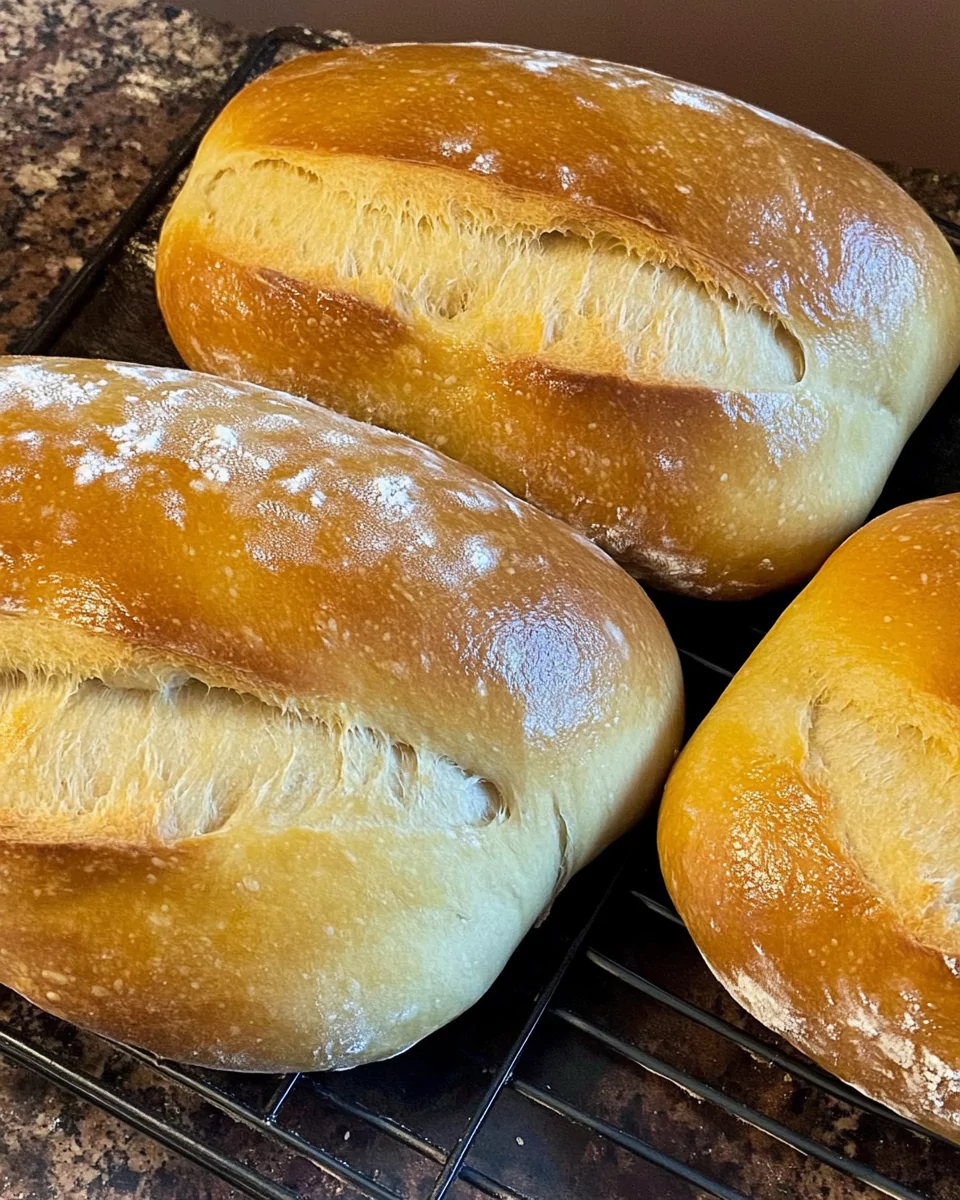This soft sourdough sandwich bread is a game-changer! With a fluffy texture and soft crust, it’s perfect for sandwiches, toast, French toast, or your favorite spreads. Its no-fuss preparation means minimal active time, making it ideal for any schedule.

Why You’ll Love This Recipe
- Soft and Versatile: Ideal for sandwiches, avocado toast, and even French toast.
- Minimal Effort: Only 10 minutes of hands-on work.
- Flexible Process: Perfect for busy schedules.
- Homemade Goodness: Skip store-bought bread for a tastier, healthier option.
Preparation Phase & Tools
Essential Tools and Equipment
- Stand Mixer with Dough Hook: Makes kneading effortless.
- Mixing Bowls: Large enough for rising dough.
- Loaf Pans: Standard 9×5-inch pans for even baking.
- Bread Lame or Razor Blade: For scoring the bread.
- Kitchen Scale: Ensures precise measurements.
- Thermometer: Checks internal bread temperature for perfect results.
Ingredients
For the Pre-ferment:
- 2 cups active sourdough starter
- 2 cups warm liquid (water, milk, or buttermilk)
- 3 cups all-purpose or bread flour
For the Dough:
- 1/4 cup fat (butter, oil, coconut oil, or beef tallow)
- 1/2 cup sweetener (honey or sugar)
- 4 teaspoons salt
- 3 cups milk or buttermilk (any kind)
- 9–11 cups all-purpose or bread flour
Step-by-Step Directions
1. Feed Your Starter
- Combine 1/2 cup sourdough starter with 2 cups flour and 1 1/3 cups warm water.
- Allow the starter to sit at room temperature until it becomes bubbly and active.
2. Prepare Pre-ferment
- In the bowl of a stand mixer, mix:
- 2 cups warm liquid (milk or buttermilk)
- 2 cups active sourdough starter
- 3 cups flour.
- Mix on low speed with the dough hook attachment for 1–2 minutes until combined. Cover the bowl and allow the mixture to ferment overnight at room temperature.
3. Mix the Dough
- Add the following to the pre-ferment mixture:
- 1/4 cup fat (melted if solid)
- 1/2 cup sweetener (honey or sugar)
- 4 teaspoons salt
- 3 cups milk or buttermilk.
- Mix on low speed until partially combined.
- Gradually add 5 cups of flour while mixing on medium speed for 5–10 minutes to develop gluten.
- Continue adding flour, 1 cup at a time, until the dough pulls away from the bowl sides but remains slightly sticky. Avoid over-flouring.
4. First Rise
- Transfer the dough to a large, oiled mixing bowl. Cover with plastic wrap or a clean towel.
- Let the dough rise in a warm spot for 2–3 hours, or until it doubles in size.
5. Shape the Loaves
- Punch down the risen dough and transfer it to a lightly floured surface.
- Divide the dough into 4 equal portions. Shape each portion into a rectangle, then roll tightly into a loaf. Tuck the edges under for a smooth finish.
- Place each loaf into a greased loaf pan.
6. Second Rise
- Cover the loaf pans with a towel and allow the dough to rise until it just peeks above the edge of the pans. This typically takes 2–3 hours, depending on the room temperature.
7. Bake
- Preheat your oven to 375°F (190°C).
- Score the tops of the loaves with a bread lame or razor blade to allow for expansion.
- Bake for 30 minutes, or until the internal temperature of the bread reaches 190°F (88°C).
8. Cool and Serve
- Carefully remove the loaves from the pans and place them on a wire rack.
- Brush the tops with butter to keep the crust soft.
- Allow the bread to cool completely before slicing.
Tips for Success
- Use warm liquids if your house is cool to encourage fermentation.
- Be patient during the rising stages—good sourdough bread takes time!
- For an even softer crust, cover the bread loosely with foil in the last 10 minutes of baking.
Serving Suggestions
This bread’s soft crumb and mild tang make it incredibly versatile. Here are some ways to enjoy it:
- Classic Sandwiches: Layer deli meats, cheese, and fresh veggies for a perfect lunch.
- Avocado Toast: Top with mashed avocado, a drizzle of olive oil, and a sprinkle of red pepper flakes.
- French Toast: Soak thick slices in a mixture of eggs, milk, and vanilla for a decadent breakfast.
- Toast with Butter and Jam: Simple, classic, and satisfying.
- Garlic Bread: Toast with butter, garlic, and parsley for a savory side dish.
- Bread Pudding: Use leftover slices for a delicious dessert.
Common Mistakes to Avoid & How to Perfect the Recipe
1. Under-proofing the Dough
- Problem: Bread turns out dense and heavy.
- Solution: Ensure the dough doubles in size during the first rise. Be patient—this step is critical.
2. Over-proofing the Dough
- Problem: Bread collapses during baking.
- Solution: Keep an eye on the dough during the second rise. It should rise just above the pan’s edge but not overflow.
3. Adding Too Much Flour
- Problem: Bread is dry and tough.
- Solution: Add flour gradually and stop when the dough is slightly sticky but manageable.
4. Skipping the Scoring Step
- Problem: Bread cracks or bakes unevenly.
- Solution: Use a sharp blade or bread lame to make shallow slashes across the top before baking.
5. Not Letting the Bread Cool Completely
- Problem: Slices are gummy or uneven.
- Solution: Allow the bread to cool entirely on a wire rack to set the crumb structure.
Side Dish Recommendations
Pair your soft sourdough sandwich bread with these sides to create balanced and satisfying meals:
1. Tomato Soup
The tangy sweetness of tomato soup pairs wonderfully with the mild tang of sourdough.
2. Cheesy Broccoli Soup
Rich and creamy, this soup complements the bread’s soft crumb.
3. Garden Salad
A fresh, crisp salad is an excellent contrast to the bread’s soft texture.
4. Homemade Butter or Jam
Elevate your bread with freshly whipped butter or seasonal jams.
5. Roasted Vegetables
Serve alongside roasted carrots, sweet potatoes, or zucchini for a hearty, healthy pairing.
6. Creamy Dips
Try it with spinach and artichoke dip or hummus for a satisfying appetizer or snack.
7. Savory Egg Salad
Spread egg salad over slices of bread for a protein-packed meal.
8. Hummus Spread
For a vegan option, serve slices with homemade or store-bought hummus.
With these serving ideas and tips, you can enjoy your soft sourdough sandwich bread in countless ways while mastering the art of baking.
Pro Tips for Success
1. Adjust for Temperature
- In cold weather, use warm liquids and allow extra time for the dough to rise.
- In hot weather, monitor the dough closely to avoid over-proofing.
2. Use High-Quality Ingredients
- Flour: Bread flour gives a chewier texture, while all-purpose flour offers a softer crumb.
- Sweeteners: Honey adds a rich flavor, while sugar keeps the flavor neutral.
3. Avoid Over-Flouring
- Add flour gradually during kneading. The dough should remain slightly sticky for a soft loaf.
4. Nail the Scoring
- Use a sharp blade or bread lame for clean slashes. This allows steam to escape and prevents cracks.
5. Cool Completely Before Slicing
- Allow the bread to cool fully on a wire rack to set the crumb and ensure clean slices.
Storage & Reheating Instructions
Room Temperature Storage
- Store in a plastic or reusable bag for up to 1 week.
- Keep the bread away from direct sunlight and heat to maintain freshness.
Refrigeration
- Store in the refrigerator for up to 10 days.
- Refrigeration may make the bread slightly drier; toast it before serving for best results.
Freezing
- Slice the bread before freezing for convenience.
- Store slices in an airtight container or freezer bags for up to 3 months.
- To use, thaw slices at room temperature or toast directly from frozen.
Reheating Tips
- For a soft texture, wrap the bread in foil and warm it in the oven at 300°F (150°C) for 10 minutes.
- Toast individual slices for a crisp edge and warm center.
FAQs
1. Can I make this bread gluten-free?
This recipe relies on gluten development for its structure, so a direct substitution won’t work. Look for gluten-free sourdough recipes instead.
2. What’s the best flour to use?
Bread flour is ideal for structure and chewiness, but all-purpose flour works for a softer crumb. Experiment to find your preference.
3. Why is my bread too dense?
Dense bread often results from under-proofing or adding too much flour. Ensure the dough doubles in size during the first rise and avoid over-flouring.
4. Can I use alternative sweeteners?
Yes, you can substitute maple syrup, agave, or even brown sugar. Keep in mind these may slightly alter the flavor.
5. Why does my crust crack during baking?
Cracks occur if the bread isn’t properly scored. Ensure you slash the top with a sharp blade to allow steam to escape.
6. Can I skip the overnight pre-ferment?
The pre-ferment is essential for developing flavor and texture. While skipping it is possible, the bread will lack the signature sourdough tang.
7. How can I make the crust softer?
Brush the crust with melted butter immediately after baking. You can also cover the loaves loosely with foil during the last 10 minutes of baking.
Conclusion
Mastering soft sourdough sandwich bread is a rewarding journey. With its fluffy texture and soft crust, this bread is perfect for any meal. Whether you’re making sandwiches, toast, or using it for French toast, this recipe offers endless versatility. Follow the tips, storage suggestions, and FAQs to bake like a pro every time.
Dive into the art of sourdough and enjoy homemade bread that’s not just delicious but also fulfilling to create!
Soft Sourdough Sandwich Bread
Ingredients
For Pre-ferment:
- 2 cups active sourdough starter
- 2 cups water milk, or buttermilk (warm if your house is cool)
- 3 cups all-purpose or bread flour
For the Dough:
- 1/4 cup fat butter, oil, melted coconut oil, or beef tallow; warm if the house is cool
- 1/2 cup sweetener honey or sugar
- 4 teaspoons salt
- 3 cups milk or buttermilk any kind; warm if the house is cool
- 9 –11 cups all-purpose or bread flour
Instructions
Feed Sourdough Starter
- Feed your sourdough starter by combining no more than 1/2 cup of starter with 2 cups flour and about 1 1/3 cups warm water.
- Let the starter sit at room temperature until it becomes active and rises to the top. Once active, proceed to the next step.
Combine Pre-ferment Ingredients
- In the bowl of a stand mixer, combine 2 cups milk or buttermilk, 2 cups active sourdough starter, and 3 cups flour.
- Mix on low speed with the dough hook attachment for about 1 minute. Cover and allow the mixture to ferment overnight at room temperature.
Mix the Dough
- The next morning, add the fat, sweetener, salt, and milk to the pre-ferment mixture. Mix on low speed until partially combined.
- Add 5 cups of flour and mix on medium speed for 5–10 minutes to develop the gluten. Gradually add 4–6 more cups of flour until the dough pulls away from the sides of the bowl and is only slightly sticky.
- Continue mixing for another 2–3 minutes.
First Rise
- Transfer the dough to a large oiled mixing bowl. Cover with a towel or plastic wrap and let it rise in a warm spot for 2–3 hours, or until it doubles in size. If it’s cold, this may take longer.
Shape the Loaves
- Once the dough has risen, punch it down and transfer it to a lightly floured surface.
- Divide the dough into 4 equal pieces. Flatten each piece into a rectangle, then fold the corners inward to form a triangle. Roll the dough away from you to form a loaf, tucking the edges under as needed.
- Place the loaves in greased loaf pans.
Second Rise
- Cover the loaves and let them rise until they’re just above the edges of the pans. This usually takes 2–3 hours, but keep an eye on them to avoid over-proofing.
Bake
- Preheat your oven to 375°F (190°C). Using a bread lame or razor blade, slash the tops of the loaves to allow for expansion.
- Bake for 30 minutes, or until the internal temperature reaches 190°F (88°C).
Cool and Enjoy
- Remove the loaves from the pans and place them on a cooling rack. Brush the tops with butter to keep the crust soft. Let the bread cool completely before slicing.
- Serve with butter and jam or use for sandwiches, toast, and more.
- Storage
- Store in a plastic bag on the counter or in the refrigerator for up to 1 week.
- Freeze for up to 3 months. For convenience, slice the bread before freezing and store individual portions in separate bags.
Notes
Adjust for Temperature: In cooler weather, use warm liquids and allow extra time for rising. In warmer weather, monitor the dough closely to prevent over-proofing.




Leave a Comment